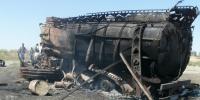On September 4, 2009, Bundeswehr pilots dropped two bombs on a wrecked oil truck outside of Kunduz in northern Afghanistan, killing more than 100 civilians. Just weeks before the Bundeswehr massacre, I visited the district where it happened and witnessed the "peace-keeping effort."
I traveled to a burial in Char Dara from Kabul with a convoy of relatives. Our Toyota van crossed the mountains without any major interruptions. Just a few hours from Kunduz, a long line of cars stood on the road. Our driver halted. The men got out and told me to stay inside.
Someone told me there was a shoot-out on the road between NATO soldiers and "taliban." In my patchy conversations with Afghans, anyone with a gun and no uniform was a "taliban," regardless of actual affiliation.
I heard clapping fusillades in the distance. A straight road stretched for about a kilometer. Occasionally, turbaned men ran across under the noon sun. A dozen or more Toyotas stood on each side of the danger zone, men in huddles besides them.
In the late summer of 2009, there was a large NATO offensive against "insurgents" around Kunduz. Locals and officials claimed these "taliban" had come to Afghanistan from Chechnya and other former Soviet regions. Fighting could break out anywhere and civilians were shot and bombed all the time.
So it was this day. After two hours of waiting, a cousin called on the phone, telling us to drive through the skirmish and hold a rag out of the window as a "white flag." One after the other, the cars passed, each waving a rag. When we drove through, I saw the gunmen waiting in the shrubs.
Half an hour after our passage, we got a call. The van my uncle and cousin drove in had been shot. They had not waved a flag. A gunman had fired a warning shot, causing the driver to speed up, so the shooter emptied his magazine on the van. One passenger had a bullet in his belly and was in critical condition. A bullet had grazed my cousin's thigh. My uncle and the driver were unharmed.
Our family gathered at a relative's house in Kunduz to spend the night. The next day, we drove out to Char Dara, although people had warned us against it. Some of my relatives worked for German organizations and were contractually prohibited from leaving their hotels, for fear of attacks. My car passed the last ISAF post, a small hill stacked with sandbags, shielding scared soldiers waiting for orders. This post must have been Elevation 431 ("Höhe 431"), which was fortified the next year.
One aim of the 2009 Bundeswehr “Operation Eagle” – the first offensive since World War II – was to establish a permanent outpost and “pacify” Char Dara, because many fighters used this Pashtun “exclave” as a retreat. (Northern Afghanistan is inhabited by various Central Asian peoples and separated from the Pashtun tribal lands in the south by the Hindu Kush mountains.)
The other aim of the offensive was to reinforce the rule of the Kabul government shortly before the 2009 national elections. Karzai is often called the “Mayor of Kabul.” He is in the same situation as his Soviet-backed predecessors.
Villagers support insurgents out of fear or common interest. ISAF “justice” makes no difference. News report that civilians die in “clashes” between “forces” not in attacks by Western mercenaries. Before my 2009 visit, an uncle's house in Char Darah had been destroyed by Bundeswehr bombers, because they suspected he was hosting “terrorists.”
Back in 2009, most relatives had already fled to Kunduz or Kabul. Afghans flee the hinterland not because of poverty – they still starve in the cities – but because the country is a war zone. Rockets also fly into Kabul every night, but the city has 5 million inhabitants. Even Obama can't kill them all; in Char Darah: Yes, he can!
I stayed in Char Dara only for one day. I fell asleep in a garden hut on our walled estate, so I missed the burial, but my cousins and uncles woke me up. Armed men had interrupted the wedding and kidnapped the same uncle who survived the previous day's shooting.
Gunmen had surrounded our farm. Apparently they wanted to take some rich visitors for ransom, including me and my relatives from Kabul. My cousins, uncle and I climbed over a wall behind a shed into a neighbors farmyard. We hid in his living room for some hours. Every Afghan house is fortified by a 3 meter wall, and I was happy for it.
My uncle phoned his German colleagues, but they were unable to help. Somehow, relatives from the village brokered a deal. Before nightfall, we were able to leave the village in taxis, driving past the insurgents' sentries. The kidnapped uncle returned a few hours later. In those two days, I learned to stay away from angry people with guns. 4 years later, the Bundeswehr still hasn't gotten the message.
This year, another “anti-rebel offensive” (Pajhwok) has driven the last members of my extended family from the district. On June 4, 2013, ISAF soldiers raided 15 villages and killed civilians, some of them relatives of mine. The “offensives” have evolved into a war, soldiers massacre people daily. Peace is further beyond the horizon than Communism. My relatives would like to come to Germany – to flee the German soldiers in their own country. But migration is illegal, unless you have a gun and a uniform.


mistake already in 1st sentence
The attack was ordered by Bundeswehr officer Klein, but it was executed by allied forces, not "Bundeswehr pilots".